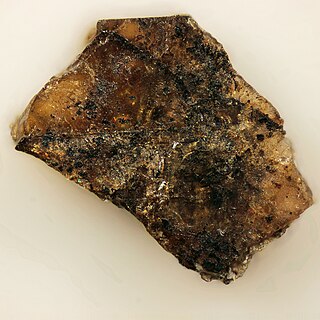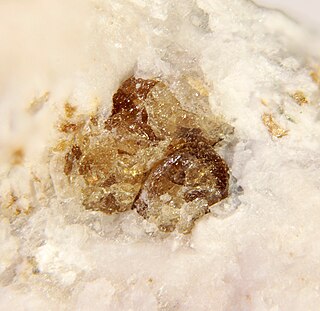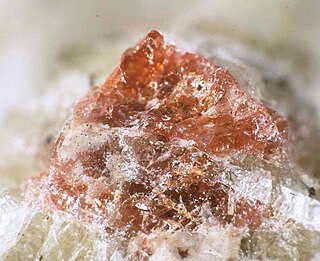Related Research Articles

Andrianovite is a very rare mineral of the eudialyte group, with formula Na12(K,Sr,Ce)6Ca6(Mn,Fe)3Zr3NbSi(Si3O9)2(Si9O27)2O(O,H2O,OH)5. The original formula was extended to show the presence of cyclic silicate groups and silicon at the M4 site, according to the nomenclature of eudialyte group. Andrianovite is unique among the eudialyte group in being potassium-rich (other eudialyte-group species with essential K are davinciite and rastsvetaevite). It is regarded as potassium analogue of kentbrooksite, but it also differs from it in being oxygen-dominant rather than fluorine-dominant. Also, the coordination number of Na in this representative is enlarged from 7 to 9. The name of the mineral honors Russian mathematician and crystallographer Valerii Ivanovich Andrianov.
Aqualite is a very rare mineral of the eudialyte group, with formula (H3O)8(Na,K,Sr)5Ca6Zr3SiSi(Si24O66)(OH)9Cl. The formula given does not show the presence of cyclic silicate groups. The original formula was extended to show the presence of silicon at both M3 and M4 sites, according to the nomenclature of the eudialyte group. Aqualite is unique among the eudialyte group in being hydronium-rich (the only other eudialyte-group species with essential hydronium, is the recently discovered ilyukhinite). Among the other representatives of the group it also distinguish in splitting of the M1 site into two sub-sites, both occupied by calcium. Thus, its symmetry is lowered from typical for most eudialytes R3m (or R-3m) to R3. The name refers to high content of water in the mineral.
Carbokentbrooksite is a very rare mineral of the eudialyte group, with formula (Na,□)12(Na,Ce)3Ca6Mn3Zr3NbSiO(Si9O27)2(Si3O9)2(OH)3(CO3).H2O. The original formula was extended to show the presence of cyclic silicate groups and silicon at the M4 site, according to the nomenclature of eudialyte group. Carbokenbrooksite characterizes in being carbonate-rich (the other eudialyte-group species with essential carbonate are zirsilite-(Ce), golyshevite, and mogovidite). It is also sodium rich, being sodium equivalent of zirsilite-(Ce), with which it is intimately associated.

Zirsilite-(Ce) is a very rare mineral of the eudialyte group, with formula (Na,□)12(Ce,Na)3Ca6Mn3Zr3NbSi(Si9O27)2(Si3O9)2O(OH)3(CO3)·H2O. The original formula was extended to show the presence of cyclic silicate groups and the presence of silicon at the M4 site, according to the nomenclature of the eudialyte group. Zirsilite-(Ce) differs from carbokentbrooksite in cerium-dominance over sodium only. Both minerals are intimately associated. The only other currently known representative of the eudialyte group having rare earth elements (in particular cerium, as suggested by the "-Ce)" Levinson suffix in the name) in dominance is johnsenite-(Ce).
Dualite is a very rare and complex mineral of the eudialyte group, its complexity being expressed in its formula Na
30(Ca,Na,Ce,Sr)
12(Na,Mn,Fe,Ti)
6Zr
3Ti
3MnSi
51O
144(OH,H
2O,Cl)
9. The formula is simplified as it does not show the presence of cyclic silicate groups. The name of the mineral comes from its dual nature: zircono- and titanosilicate at once. Dualite has two modules in its structure: alluaivite one and eudialyte one. After alluaivite and labyrinthite it stands for third representative of the eudialyte group with essential titanium.
Labyrinthite is a very rare mineral of the eudialyte group. When compared to other species in the group, its structure is extremely complex – with over 100 sites and about 800 cations and anions – hence its name, with its complexity expressed in its chemical formula (Na,K,Sr)35Ca12Fe3Zr6TiSi51O144(O,OH,H2O)9Cl3. The formula is simplified as it does not show the presence of cyclic silicate groups. Complexity of the structure results in symmetry lowering from the typical centrosymmetrical group to R3 space group. Other eudialyte-group representatives with such symmetry lowering include aqualite, oneillite, raslakite, voronkovite. Labyrinthite is the second dual-nature representative of the group after dualite and third with essential titanium after dualite and alluaivite.
Feklichevite is a rare mineral of the eudialyte group with the formula Na11Ca9(Fe3+,Fe2+)2Zr3NbSi(Si3O9)2(Si9O27)2. The original formula was extended to show the presence of cyclic silicate groups and presence of silicon at the M4 site, according to the nomenclature of eudialyte group. When compared to other minerals of the group, feklichevite characterizes in the presence of ferric iron (thus similar to ikranite, mogovidite and fengchengite) and dominance of calcium at the N4 site. Calcium is ordered in the structure and is also present at the M1 site. Other iron-bearing minerals of the group are eudialyte, ferrokentbrooksite, georgbarsanovite, khomyakovite, labyrinthite, oneillite and rastsvetaevite, but they rather contain ferrous iron Feklichevite name honors Russian mineralogist and crystallographer, V. G. Feklichev.
Fengchengite is a rare mineral of the eudialyte group with the formula Na12[ ]3(Ca,Sr)6Fe33+Zr3Si(Si25O73)(H2O,OH)3(OH,Cl)2. The formula is simplified as it does not show the presence of cyclic silicate groups. When compared to other minerals of the group, fengchengite characterizes in the presence of ferric iron and essential, site-dominating vacancies. The mineral was discovered in the Saima complex near Fengcheng city in China – hence its name.

Ferrokentbrooksite is a moderately rare mineral of the eudialyte group, with formula Na15Ca6(Fe,Mn)3Zr3NbSi25O73(O,OH,H2O)3(Cl,F,OH)2. The original formula was extended form to show the presence of cyclic silicate groups and presence of silicon at the M4 site, according to the nomenclature of eudialyte group. As suggested by its name, it is the (ferrous) iron analogue of kentbrooksite. When compared to the latter, it is also chlorine-dominant instead of being fluorine-dominant. The original (holotype) material is also relatively enriched in rare earth elements, including cerium and yttrium.

Georgbarsanovite is a very rare mineral of the eudialyte group, formerly known under unaccepted name as barsanovite, with formula Na12(Mn,Sr,REE)3Ca6Fe32+Zr3NbSi(Si3O9)2(Si9O27)2O4Cl2·H2O. The original formula was extended to show the presence of cyclic silicate groups and the domination of silicon at the M4 site. "REE", standing for rare earth elements, is dominated by cerium. Georgbarsanovite is characterized in dominance of manganese at the N4 site. It also differs from most other accepted group representatives in its colour. The mineral was found in nepheline pegmatite near Petrelius River, Khibiny massif, Kola Peninsula, Russia. It is named after Russian mineralogist Georg Barsanov.

Golyshevite is a rare mineral of the eudialyte group, with the formula Na10Ca3Ca6Zr3Fe2SiNb(Si3O9)2(Si9O27)2CO3(OH)3•H2O. The original formula was extended to show both the presence of cyclic silicate groups and silicon at the M4 site, according to the nomenclature of the eudialyte group. The characteristic feature of golyshevite is calcium-rich composition, with calcium at two main sites instead of one site. Together with feklichevite, fengchengite, ikranite and mogovidite it is a ferric-iron-dominant representative of the group. It is chemically similar to mogovidite. Golyshevite was named after Russian crystallographer Vladimir Mikhailovich Golyshev.
Johnsenite-(Ce) is a very rare mineral of the eudialyte group, with the chemical formula Na12(Ce,La,Sr,Ca,[ ])3Ca6Mn3Zr3WSi(Si9O27)2(Si3O9)2(CO3)O(OH,Cl)2. The original formula was extended to show the presence of both the cyclic silicate groups and silicon at the M4 site, according to the nomenclature of the eudialyte group. It is the third eudialyte-group mineral with essential tungsten, and second with essential rare earth elements. In fact, some niobium substitutes for tungsten in johnsenite-(Ce). Other characteristic feature is the presence of essential carbonate group, shared with carbokentbrooksite, golyshevite, mogovidite and zirsilite-(Ce).

Khomyakovite is an exceedingly rare mineral of the eudialyte group, with formula Na12Sr3Ca6Fe3Zr3W(Si25O73)(O,OH,H2O)3(OH,Cl)2. The original formula was extended to show the presence of both the cyclic silicate groups and M4-site silicon, according to the nomenclature of the eudialyte group. Some niobium substitutes for tungsten in khomyakovite. Khomyakovite is an iron-analogue of manganokhomyakovite, the second mineral being a bit more common. The two minerals are the only group representatives, beside taseqite, with species-defining strontium, although many other members display strontium diadochy. Khomyakovite is the third eudialyte-group mineral with essential tungsten.

Manganokhomyakovite is a very rare mineral of the eudialyte group, with the chemical formula Na12Sr3Ca6Mn3Zr3WSi(Si9O27)2(Si3O9)2O(O,OH,H2O)3(OH,Cl)2. This formula is in extended form, to show the presence of cyclic silicate groups and domination of silicon at the M4 site, basing on the nomenclature of the eudialyte group. Some niobium substitutes for tungsten in khomyakovite. As suggested by its name, manganokhomyakovite is a manganese-analogue of khomyakovite, the latter being more rare. The two minerals are the only group representatives, beside taseqite, with species-defining strontium, although many other members display strontium diadochy. Manganokhomyakovite is the third eudialyte-group mineral with essential tungsten.

Kentbrooksite is a moderately rare mineral of the eudialyte group, with chemical formula (Na,REE)15(Ca,REE)6Mn3Zr3NbSi[(Si9O27)2(Si3O9)2O2]F2·2H2O. This extended formula shows the presence of cyclic silicate groups and dominance of Si at the M4 site, according to the nomenclature of the eudialyte group. The characteristic features of kentbrooksite, that make it different from eudialyte are: (1) dominancy of fluorine (the only currently known example among the whole group), (2) dominancy of manganese, and (3) dominancy of niobium. Trace hafnium and magnesium are also reported. Kentbrooksite is relatively common when compared to most other species of the group.

Manganoeudialyte is an moderately rare mineral of the eudialyte group, with formula Na14Ca6Mn3Zr3Si2[Si24O72(OH)2]Cl2·4H2O. The formula given is one of the forms that can be given, based on the originally reported one, and shows dominance of silicon at both the M3 and M4 sites. As suggested by its name, it is the manganese-analogue of eudialyte.
Voronkovite is a very rare mineral of the eudialyte group with the chemical formula Na15(Na,Ca,Ce)3(Mn,Ca)3Fe3Zr3Si2Si24O72(OH,O)4Cl·H2O. The formula is based on the simplified original one; it does not show the presence of cyclic silicate groups, but two M3- and M4-site silicon atoms are shown separately (basing on the nomenclature of the eudialyte group). Voronkovite has lowered symmetry (space group R3, instead of more specific for the group R3m one), similarly to some other eudialyte-group members: aqualite, labyrinthite, oneillite and raslakite. The specific feature of voronkovite is, among others, strong enrichment in sodium.

Raslakite is a rare mineral of the eudialyte group with the chemical formula Na15Ca3Fe3(Na,Zr)3Zr3(Si,Nb)SiO(Si9O27)2(Si3O9)2(OH,H2O)3(Cl,OH). This formula is based on the original one, and is extended to show the presence of cyclic silicate groups. The additional silicon and oxygen shown in separation from the cyclic groups are in fact connected with two 9-fold rings. The mineral has lowered symmetry, similarly to some other eudialyte-group members: aqualite, labyrinthite, oneillite and voronkovite. The specific feature of raslakite is, among others, the presence of sodium and zirconium at the M2 site. Raslakite was named after Raslak Cirques located nearby the type locality.

Rastsveatevite is a rare mineral of the eudialyte group with the chemical formula Na27K8Ca12Fe3Zr6Si4[Si3O9]4[Si9O27]4(O,OH,H2O)6Cl2. Its structure is modular. It is only the third member of the group after andrianovite and davinciite with essential (site-dominating) potassium. Potassium and sodium enter both N4 and M2 sites. The mineral is named after Russian crystallographer Ramiza K. Rastsvetaeva.
Dachiardite-K is a rare zeolite-group mineral with the formula K4(Si20Al4O48)•13H2O. It is the potassium-analogue of dachiardite-Ca and dachiardite-Na, as suggested by the suffix "-K".
References
- ↑ Warr, L.N. (2021). "IMA–CNMNC approved mineral symbols". Mineralogical Magazine. 85 (3): 291–320. Bibcode:2021MinM...85..291W. doi: 10.1180/mgm.2021.43 . S2CID 235729616.
- 1 2 3 Mindat
- ↑ https://www.mineralienatlas.de/lexikon/index.php/MineralData?mineral=Ilyukhinite Mineralienatlas
- ↑ Chukanov, N.V., Rastsvetaeva, R.K., Rozenberg, K.A., Aksenov, S.M., Pekov, I.V., Belakovskiy, D.I., and Kristiansen, R., 2015, Ilyukhinite, IMA 2015-065. CNMNC Newsletter No. 28, December 2015, 1860; Mineralogical Magazine 79, 1859–1864